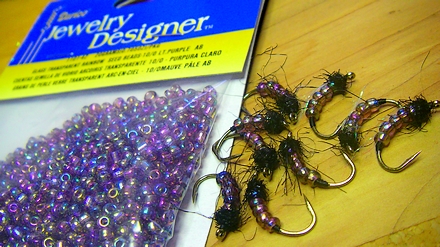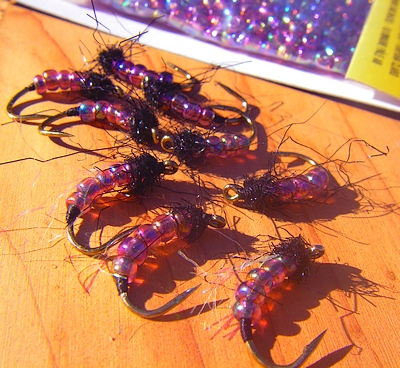It’s more of a preoccupation with efficiency, cheap materials, fast tying, and desirable physics.
Fast sinking flies allow me to cast at the target, and with low water and the increase in algae – it usually means I’m dragging less debris when the fly enters the “eat” zone. “Keeling” the fly so the point rides upwards gives me a slim chance at avoiding the bottom – giving the fly the ability to make contact without being hung or gathering debris and increasing the size of the fly.

Me, I just like the color. It’s consistent with my preference for blended dubbing – with multiple component colors present to present fish whatever color he likes best. These are 10/0 Mauve beads with an oily iridescent sheen, presenting multiple colors to a hungry fish, and hopefully inducing him to grab.
I was using these much of yesterday – one of those flies you can tie two dozen an hour; perfect for gifting pals and aggressive casting, where adorning a tree branch means you’re dry eyed and vengeful.

I call them “Jelly Bellies” as they’ve got that squishy-translucent, worm look to them. It’s a nice searching pattern with plenty of color – and reacts differently to direct sunlight or indirect lighting. The photo at top is indirect indoor lights, and the above is direct sunlight, note the pronounced rose tint to the glass. The foreground three are tied with a few fibers of aurora blaze Angelina over the top, adding some flash akin to Gary Lafontaine’s Sparkle Pupa.
You could go the “green” route and claim they’re lead free, or please your PETA buddies because everything on the fly is synthetic, but the real value is banging out 3-4 dozen while watching listening to the pundits describe the earthbound spiral of your retirement fund.
I scored these at Joann’s Fabrics, about a buck for a lifetime supply, and trout love them.

hey jewelry designer, are those beads plastic?
I’ve got some glass czech beads in that color that I have tied up before in an eerily similar fashion. You sure you haven’t looked at my fly box before?
The pattern looks like it could resemble several items, though I wonder if the fish think they are sowbugs? What sizes are you tying them up in?
The beads are glass (glass is heavier than plastic)- the above are tied on #10 Togen Scud hooks, I’ve used a variety of sizes – but the #10, #12’s are about perfect for the 10/0 bead.
The larger hook keeps the 3 inch bass off, although they try desperately to eat the beast.
cool thanks. I feel the size 10’s fit my style of nymph fishing well. I also fish 8’s and 6’s for roughfish, but 10 is the perfect size to cover most species of fish.
I would have chosen to tie that pattern on a size 10 scud hook with glass beads as well. I’ll have to tie up a couple this fall/winter and give them a go.
Whats next a rinestone emblazzed fishing vest with matching sequen boots?
At a distance my vest looks like the landing lights for LAX – easy for my buddies to find me in the dark.
Just so you filthy Brownliners don’t start to feel too Masters of Universe-ish, here’s a glass caddis pattern I fished a couple years ago, though I dipped it in Softex to “connect” the beads and give it some longevity, though I stole a little of the shine.
But there’s no dry fly hackle on your creation, am I going to have to come up there and feel your forehead?
I’m a man of mystery and shadow. And I thought we covered the whole touching thing.